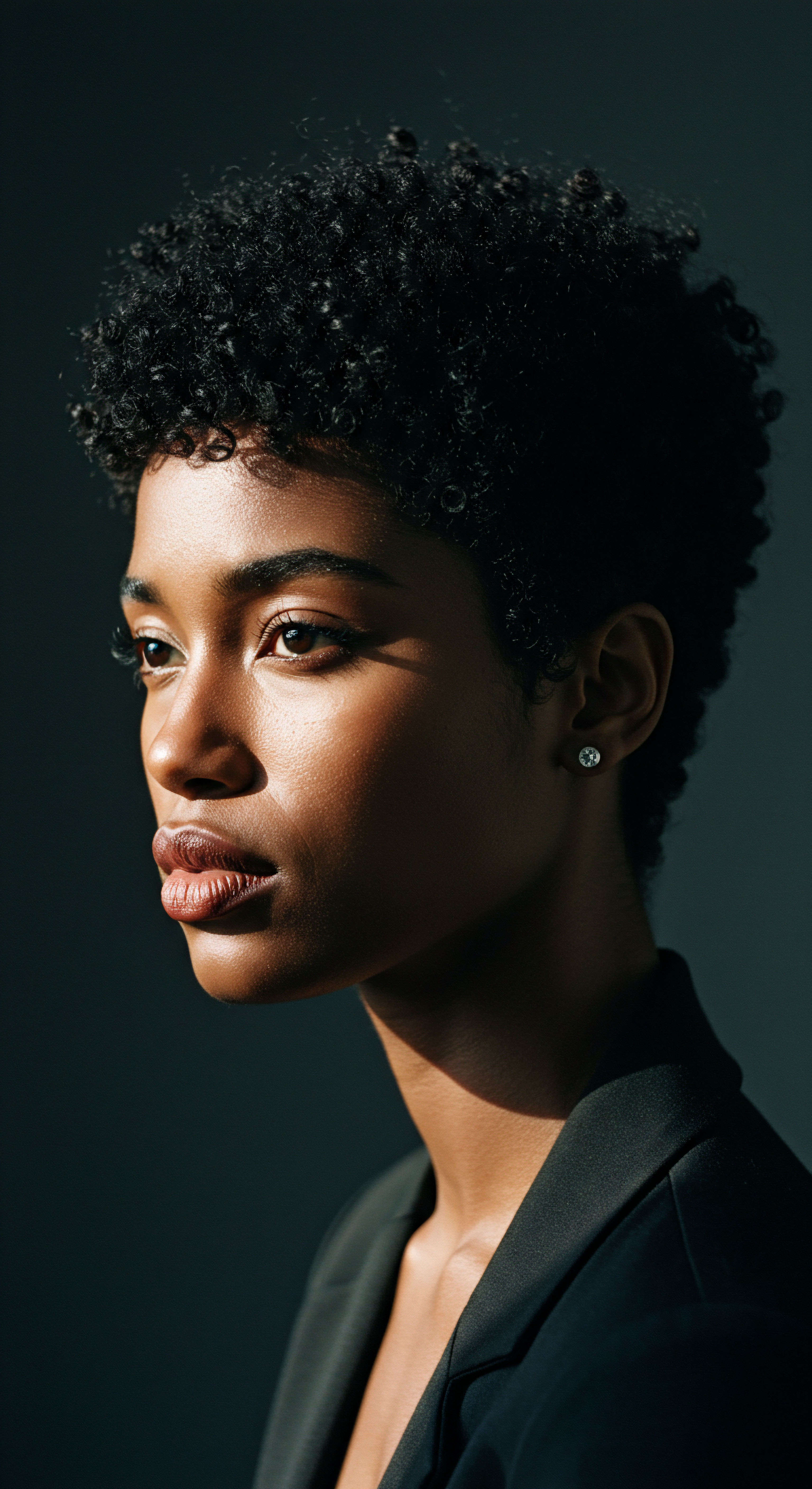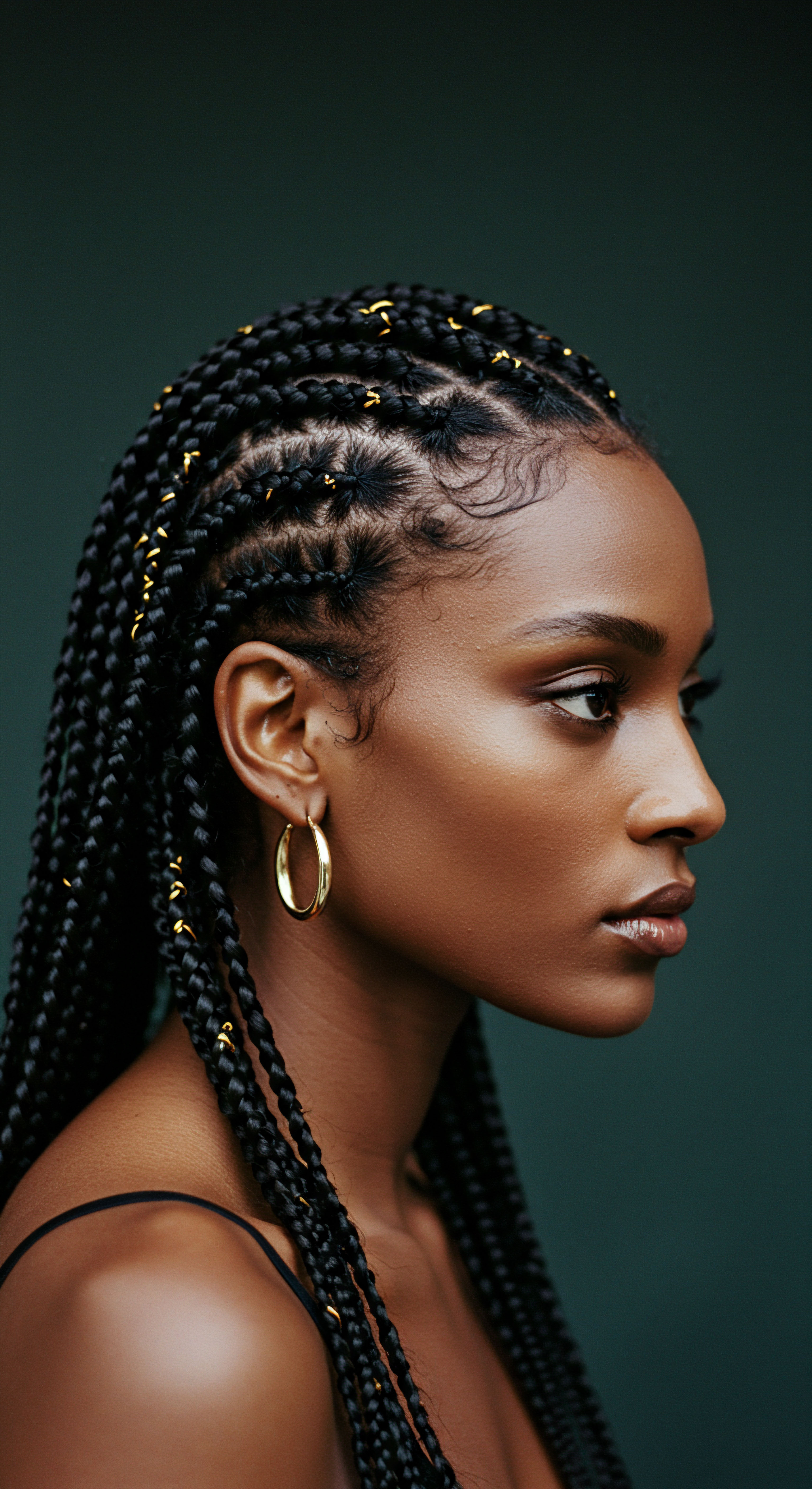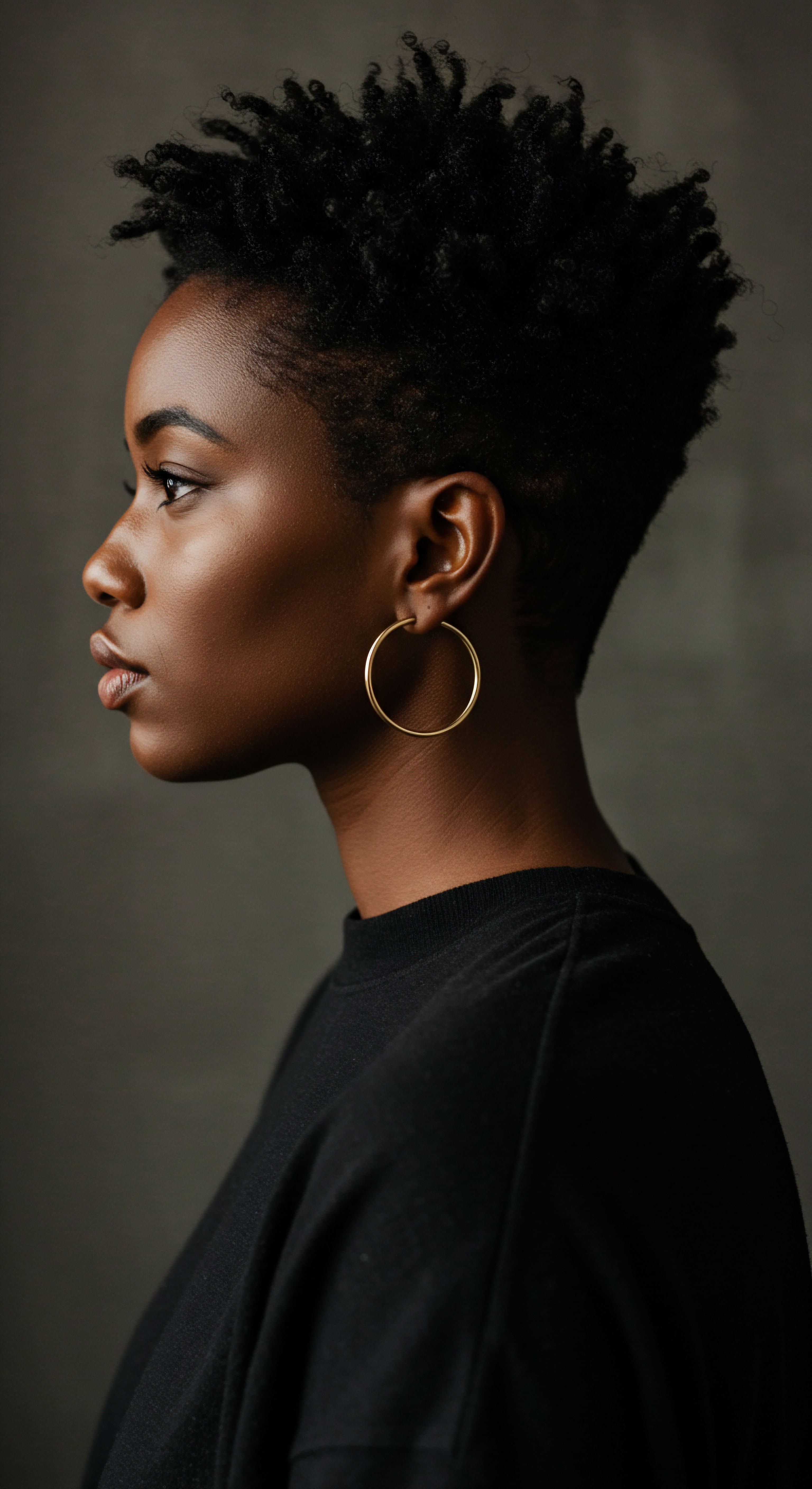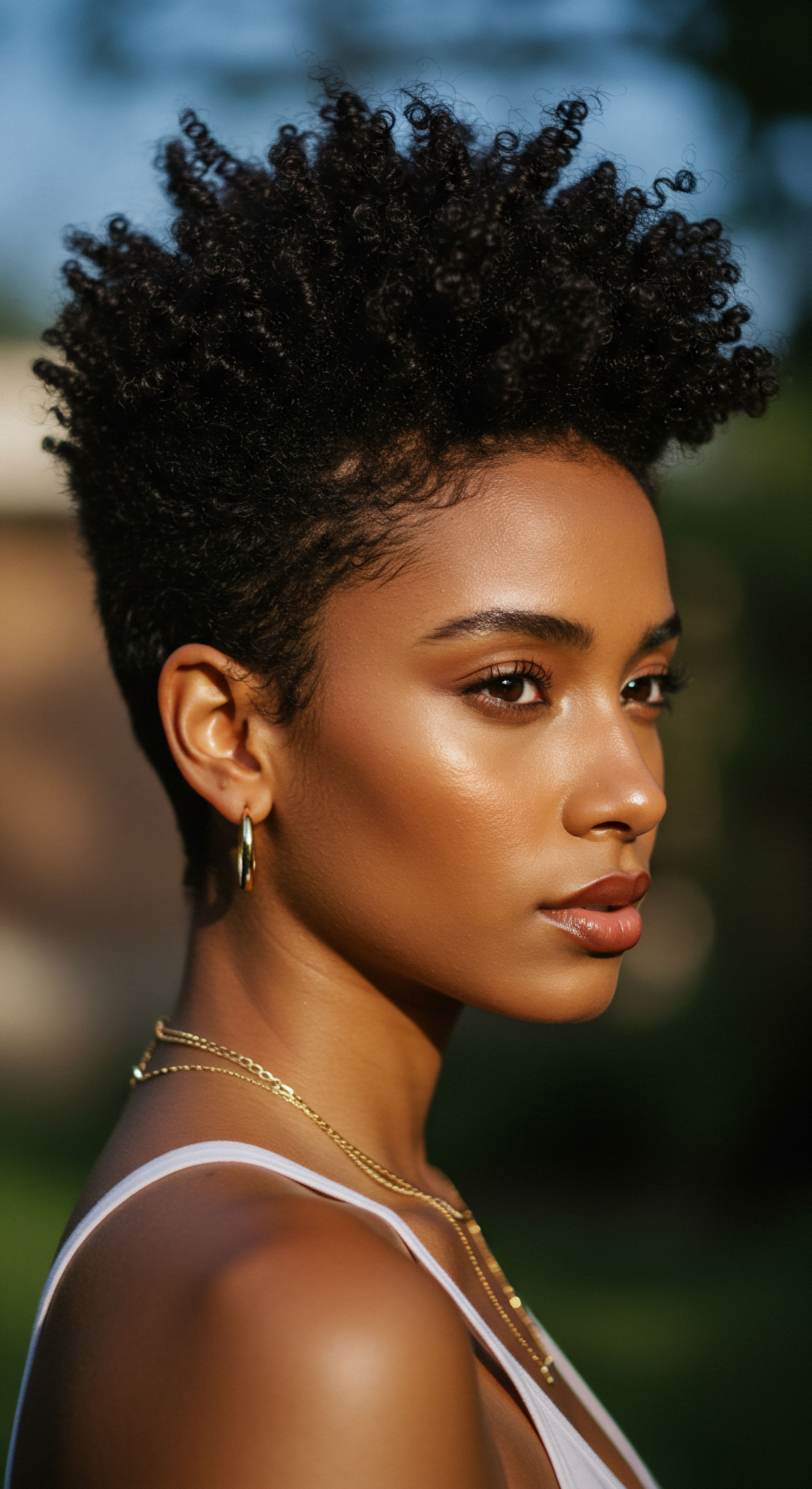
Roots
The quiet hours of slumber, often perceived as a time of peaceful restoration for body and mind, can unwittingly become a period of subtle stress for coily hair. For those blessed with the intricate spirals and resilient textures of coily strands, the night holds a particular significance. It is a time when the delicate architecture of each strand, with its unique bends and turns, can either find solace or face challenges that compromise its natural splendor. Understanding the fundamental nature of coily hair—its inherent dryness, its thirst for hydration, and its distinctive cuticle structure—is the first step in crafting a nighttime sanctuary that truly serves its needs.
Coily hair, with its remarkable spring and volume, possesses a cuticle layer that tends to be more open than straighter textures. This characteristic, while contributing to its magnificent appearance, also means that moisture, so vital for its health, can escape more readily. This predisposition to dryness makes overnight care not merely a luxury, but a protective necessity. When these thirsty strands encounter abrasive surfaces or are left without thoughtful arrangement, the consequences manifest as tangles, breakage, and a loss of definition that can diminish the vibrancy of morning curls.
The unique structure of coily hair, with its open cuticle, makes it inherently prone to moisture loss, highlighting the importance of mindful overnight care.

Understanding the Hair’s Micro-Landscape
Each individual hair fiber is a marvel of biological engineering. At its core lies the medulla, surrounded by the cortex, which provides strength and elasticity. Encasing these inner layers is the cuticle, a protective outer shell composed of overlapping scales, similar to shingles on a roof.
In coily hair, these scales do not lie as flat as they might on straight hair, creating more points of potential friction and pathways for hydration to escape. This structural reality dictates a gentle approach to all aspects of care, especially when hair is most vulnerable during sleep.
The journey of a single strand, from its follicular home to its ends, is a testament to resilience. Yet, even the most robust coily hair can succumb to repeated mechanical stress. The pillow, an innocent companion to our rest, can become an antagonist to hair health if its surface promotes snagging and absorbs precious moisture. This nightly interaction, seemingly minor, compounds over time, contributing to the very issues we seek to avoid ❉ dryness, dullness, and diminished vitality.

What Makes Coily Hair Susceptible to Nighttime Distress?
The very characteristics that give coily hair its distinct beauty also render it particularly vulnerable during hours of repose. The tightly wound spirals mean that each strand has more surface area exposed to potential friction. Furthermore, the natural oils produced by the scalp, which effortlessly travel down straight strands, often struggle to descend the twists and turns of coily hair, leaving the lengths and ends more parched.
- Coil Shape ❉ The intricate spiral pattern of coily hair means individual strands frequently intersect and rub against each other, as well as external surfaces.
- Cuticle Lift ❉ The cuticle scales on coily hair are often naturally raised, allowing for easier entry and exit of water molecules, leading to quicker dehydration.
- Sebum Distribution ❉ Natural scalp oils, crucial for lubrication and protection, do not readily travel the full length of coily strands, leaving ends susceptible to dryness.
Acknowledging these intrinsic qualities is the first step toward building a thoughtful overnight regimen. It is about honoring the hair’s natural inclinations and providing a nurturing environment that counters its vulnerabilities, allowing it to remain vibrant and healthy through the night and into the new day.

Ritual
Stepping from the foundational understanding of coily hair’s nature, we arrive at the practical wisdom of daily and nightly practices. The act of preparing coily hair for rest is not merely a chore, but a thoughtful ritual, a conscious act of preservation that yields tangible benefits by morning. This period of quiet preparation sets the stage for strands to retain their hydration, preserve their shape, and avoid the friction that can lead to unwelcome tangles and breakage.
The choices made before settling into sleep significantly influence the hair’s condition upon waking. Simple yet profound adjustments to a nighttime routine can transform hair from vulnerable to protected, allowing it to retain its moisture and integrity. This section explores the methods and tools that form the cornerstone of effective overnight protection for coily hair, guiding you toward a serene and restorative slumber for your strands.
A consistent nighttime ritual, including specific styling and material choices, provides essential protection for coily hair.

Selecting the Right Sleeping Surface
The material against which your hair rests throughout the night plays a decisive role in its well-being. Cotton, a widely used fabric for pillowcases, is known for its absorbency and its slightly rough surface. While comfortable for skin, it can draw moisture from hair and create friction as you shift during sleep. This mechanical interaction can disturb the hair’s cuticle, leading to frizz, tangles, and eventual breakage.
In contrast, smoother materials present a more favorable environment. Silk and Satin pillowcases or head coverings offer a gliding surface that reduces mechanical stress on the hair shaft. This reduced friction helps to keep the cuticle layer smooth and intact, thereby minimizing moisture loss and preserving curl definition. The choice of material is a silent yet powerful guardian for coily strands.
| Material Type Silk |
| Key Benefit for Coily Hair Reduces friction, retains moisture, hypoallergenic. |
| Consideration Natural fiber, may be a higher initial cost. |
| Material Type Satin |
| Key Benefit for Coily Hair Reduces friction, helps retain moisture, more accessible. |
| Consideration Synthetic alternative, less breathable than silk. |
| Material Type Cotton |
| Key Benefit for Coily Hair Breathable for scalp. |
| Consideration High friction, absorbs hair moisture. |
| Material Type Selecting the right material is a fundamental step in overnight hair preservation. |

Gentle Styling Methods for Sleep
Beyond the surface upon which hair rests, the way coily strands are arranged before sleep significantly impacts their morning appearance and health. Tight styles, while offering temporary definition, can place undue tension on the hair roots and along the shaft, contributing to damage over time. The aim is to create loose, protective arrangements that minimize manipulation and maintain hydration.
Consider the Pineapple Method for longer coily hair. This involves gathering all hair into a very loose, high ponytail or bun at the very top of the head, secured with a soft satin or silk scrunchie. The hair then cascades freely, minimizing contact with the pillow. This method helps to preserve volume and definition, particularly for wash-and-go styles.
For shorter hair, or for those desiring more stretched results, loose braids or twists can be beneficial. These styles coil the hair in a controlled manner, preventing tangles and stretching the curls slightly, which can be desirable for certain looks.
Another approach involves Banding, where soft fabric bands are placed along the length of a ponytail or sections of hair, gently stretching the hair without tension. This can help to reduce shrinkage and maintain length overnight. Regardless of the chosen style, the emphasis remains on softness, minimal tension, and materials that respect the hair’s delicate nature.

Hydration Before Rest
Coily hair thrives on moisture, and the night offers a prime opportunity to replenish it. Applying a leave-in conditioner or a light hair oil before styling for bed can create a protective barrier that seals in hydration. This pre-sleep application helps to counter the natural moisture loss that occurs overnight and prepares the hair to greet the morning with softness and elasticity.
The choice of hydrating products should align with individual hair needs. Some may prefer a water-based leave-in for a light layer of moisture, while others might benefit from a richer cream or a blend of botanical oils to provide deeper conditioning. The key is to apply just enough to coat the strands without oversaturating, ensuring the hair can still breathe. This thoughtful hydration step complements the physical protection offered by sleep accessories and styling, creating a comprehensive approach to overnight care.

Relay
Moving beyond the foundational and the ritualistic, we now delve into the intricate interplay of science, history, and the profound impact of overnight practices on coily hair. The seemingly simple act of resting can reveal layers of biological and environmental complexities that shape hair health. Understanding these deeper mechanisms allows for a more informed, responsive approach to care, one that acknowledges both the hair’s inherent design and the external forces it encounters.
The vulnerability of coily hair to mechanical stress, particularly during sleep, is not merely anecdotal; it is grounded in the physics of friction and the biology of the hair shaft. As the head shifts upon a pillow, the hair fibers rub against the fabric, creating a dynamic interaction that can be either gentle or destructive. This constant rubbing can lift the delicate cuticle scales, exposing the inner cortex to dehydration and damage.
The science of sleep and hair reveals how nightly friction and moisture dynamics significantly impact coily hair health.

How Does Fabric Choice Impact Hair Integrity?
The surface against which coily hair rests profoundly influences its condition. Cotton, a common pillowcase material, is known for its absorbency and its slightly textured surface. This texture, at a microscopic level, creates significant friction with hair fibers. Studies on hair friction highlight this impact.
For instance, research indicates that Cotton Textiles can Exhibit a Higher Coefficient of Friction When Slid against Human Hair Compared to Smoother Materials Like Polyester or Silk. This increased friction translates directly to mechanical stress on the hair cuticle.
When the cuticle, the hair’s outermost protective layer, is disturbed by this friction, it can lift and chip, leading to a cascade of undesirable outcomes. This damage not only results in visible frizz and tangles but also compromises the hair’s ability to retain its internal moisture. The consequence is drier, more brittle strands that are prone to breakage.
Conversely, materials like silk and satin, with their smooth, tightly woven structures, offer a significantly lower coefficient of friction, allowing hair to glide rather than snag. This difference in frictional properties is a key reason for their advocacy in textured hair care.

The Deeper Science of Moisture Retention
Beyond friction, the hygroscopic properties of sleep surfaces directly influence hair hydration. Coily hair, due to its structural characteristics, is inherently predisposed to moisture loss. Cotton, being a hydrophilic fiber, readily absorbs water. This means that not only does it create friction, but it also actively draws moisture from the hair throughout the night.
A significant finding in this area comes from a study reported in the Journal of Textile Science and Technology, which highlighted the striking difference in moisture retention among various pillowcase materials. This research indicated that Silk Pillowcases Retained an Impressive 97% of Moisture, a Stark Contrast to Cotton, Which Retained Only 75%, and Satin, Which Held 60%. This data underscores the profound impact of material choice on maintaining the hair’s hydration levels during prolonged periods of rest. The difference of over 20 percentage points between silk and cotton in moisture retention is a compelling argument for opting for silk, especially for coily hair that already struggles with dehydration.
This difference is not merely about comfort; it is about preserving the delicate lipid layers that coat the hair shaft, which are crucial for maintaining its barrier function and elasticity. When these lipids are stripped or compromised by moisture absorption from the environment, the hair becomes more vulnerable to damage and loses its natural resilience.
- Cuticle Integrity ❉ A smooth, undisturbed cuticle acts as a shield, preventing moisture from escaping the hair’s inner core.
- Lipid Preservation ❉ Materials that do not absorb hair’s natural oils and applied products help to maintain the hair’s protective lipid barrier.
- Reduced Static ❉ Low-friction surfaces also minimize static electricity, which can further disrupt the cuticle and lead to frizz.

Historical Echoes and Modern Science
The practice of protecting hair during sleep is not a modern invention; it echoes through centuries of cultural wisdom. Across various African and Indigenous traditions, head coverings and specific styling methods were employed not only for aesthetic or spiritual reasons but also for practical preservation. From intricately wrapped scarves to carefully braided styles, these historical practices implicitly understood the need to shield hair from environmental elements and mechanical stress, including that encountered during sleep.
Modern science, with its tools of tribology and microscopy, now provides quantifiable evidence for the efficacy of these age-old customs. The intuitive wisdom of ancestors, who understood the vulnerabilities of textured hair, finds its scientific validation in studies demonstrating how friction and moisture dynamics truly shape hair health. The careful braiding, the use of natural butters, and the wrapping of hair before rest were, in essence, early forms of protective styling and moisture retention strategies, long before the terms “coefficient of friction” or “lipid layer” entered common parlance.
This convergence of historical practice and contemporary research reinforces the idea that the best way to care for coily hair overnight is a harmonious blend of inherited wisdom and scientific understanding. It is a testament to the enduring human capacity to observe, adapt, and protect, ensuring the vibrancy of hair for generations.

Reflection
The journey of understanding how best to care for coily hair through the quiet hours of night extends beyond mere techniques and materials; it speaks to a deeper connection with one’s self and heritage. Each deliberate choice, from the gentle gathering of spirals to the selection of a smooth resting surface, is an affirmation of care, a quiet conversation with the very essence of who we are. It is a recognition that true beauty blossoms from a place of respect and thoughtful attention, allowing our hair to retain its unique vitality and respond to the gentle touch of morning light. This continuous dance between daily living and nightly restoration becomes a testament to resilience, a celebration of inherent beauty, and a quiet commitment to self-preservation.

References
- Bhushan, B. et al. “Friction Dynamics of Straight, Curly, and Wavy Hair.” Journal of Applied Physics, vol. 115, no. 13, 2014.
- Schwartz, A. M. and Knowles, D. C. “Frictional Effects in Human Hair.” Journal of the Society of Cosmetic Chemists, vol. 14, no. 2, 1963.
- Ahn, H. J. et al. “The Ethnic Differences of the Damage of Hair and Integral Hair Lipid after Ultra Violet Radiation.” Annals of Dermatology, vol. 23, no. 2, 2011.
- Das, D. and Kothari, V. K. “Studies on Friction in Cotton Textiles ❉ Part I-A Study on the Relationship Between Physical Properties and Frictional Characteristics of Cotton Fibres and Yarns.” Indian Journal of Fibre & Textile Research, vol. 30, 2005.
- El-Messiry, M. et al. “A Study on the Electrostatic Charge Generated From the Friction of Wig Cap Textiles Against Human Skin and Hair.” Journal of Textile Science and Technology, vol. 3, no. 1, 2017.
- Robbins, C. R. and Crawford, D. “Analysis of Hair Lipids and Tensile Properties as a Function of Distance From Scalp.” Journal of Cosmetic Science, vol. 42, no. 5, 1991.
- Dias, M. F. R. G. “The What, Why and How of Curly Hair ❉ A Review.” Journal of Cosmetic Dermatology, vol. 18, no. 6, 2019.
- Draelos, Z. D. and Callender, V. D. “Techniques Used for Hair Style Maintenance While Sleeping May Be a Risk Factor for Traction Alopecia.” Skin Appendage Disorders, vol. 7, no. 2, 2021.
- Callender, V. D. et al. “Historical Perspectives on Hair Care and Common Styling Practices in Black Women.” Journal of the American Academy of Dermatology, vol. 82, no. 6, 2020.
- “Silk Pillowcase Retained 97% of Moisture, Compared to 75% for Cotton and 60% for Satin.” As reported by Blissy, citing a study published in the Journal of Textile Science and Technology.